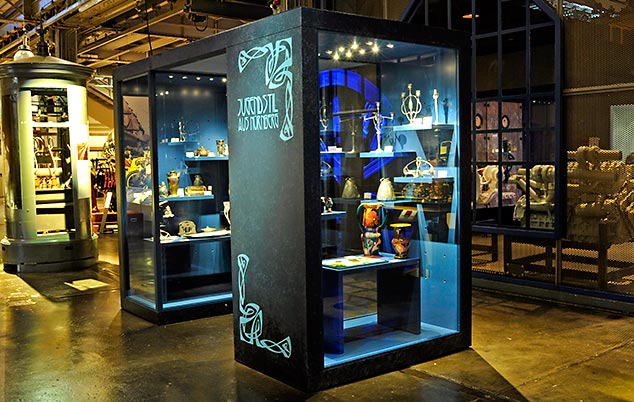
Until recently, Jugendstil in Nuremberg has been very sparsely represented at the Museum for Industrial Culture. But now it appears in a specially built, permanent walk-in display on Museum Lane. In this new unit of the museum, a selection of exhibits that will change each year highlights the history of Nuremberg Jugendstil, with exceptionally high-quality, imaginative decorative and practical items from various makers.
Around 1900, Nuremberg had a successful community of artisans, designers and art-oriented manufacturers producing Jugendstil items. This style, Germany's version of art nouveau, enjoyed a heyday here starting in 1897 at Johann von Schwarz's ceramic factory, with Carl Sigmund Luber as its artistic director. Luber developed an imaginative range of products with perfectly executed underglaze painting, including vases, jugs and pitchers, and wall tiles. Two years later, in 1899, Walter Scherf's metalware factory joined the movement, making cast pewter items like candlesticks, picture and mirror frames, decorative plates, small boxes, and the like, that could stand comparison with any work of the kind by other makers in Germany and internationally. Other important workshops and businesses included Ignaz Bing, Johann Brand & Stauch, Simon Felsenstein & Sigmund Mainzer, Franz Kainzinger, Emil Kellermann, Friedrich Müller and Georg Friedrich Schmitt.
In 1901 the Bavarian Crafts Museum began organizing master classes in artistic crafts to familiarize Nuremberg artisans with the formal vocabulary of the Jugendstil movement. The initiative brought outstanding designers to the city for several weeks every year until 1913, teaching the style's refinements and other techniques. Women also attended these courses, working primarily in textiles. In 1906, exactly ten years after the first appearance of Jugendstil in Nuremberg, tastes turned away toward other forms of artistic expression and Jugendstil came to an end, not just here but in many other places as well.
The exhibition is based on the collection by Maria and Claus Pese that was donated to the City of Nuremberg for its museums in 2016 and offers a representative cross-section of Nuremberg Jugendstil's abundance and diversity of forms and decoration.


